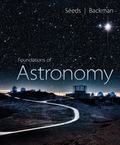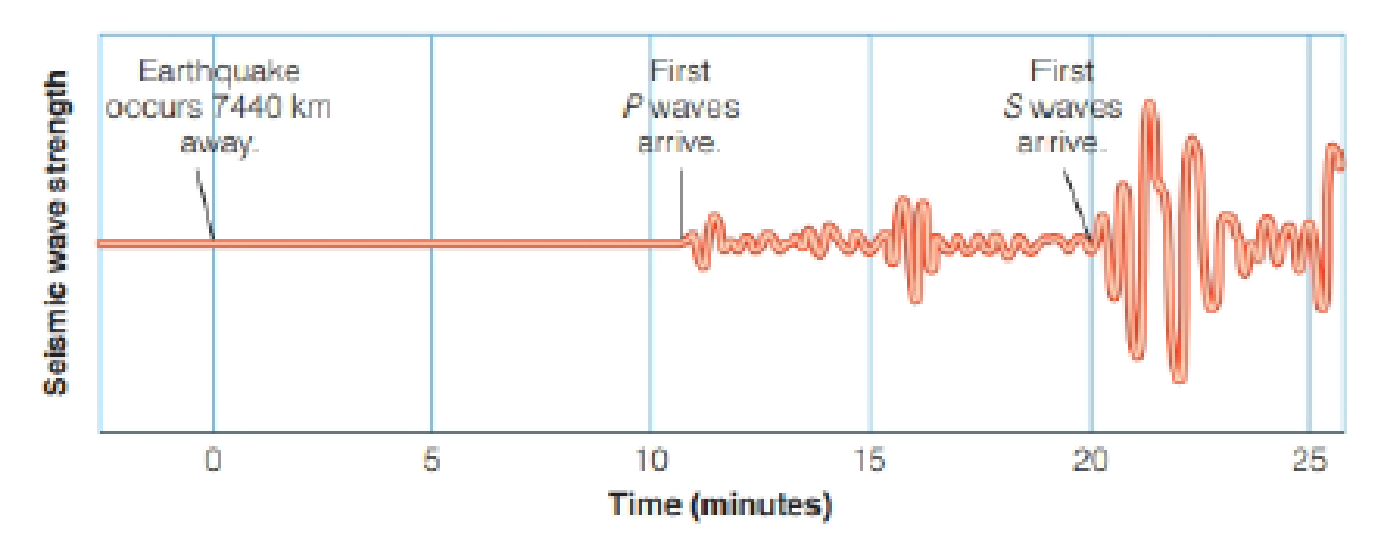
EBK FOUNDATIONS OF ASTRONOMY
14th Edition
ISBN: 9781337670968
Author: Backman
Publisher: CENGAGE LEARNING - CONSIGNMENT
expand_more
expand_more
format_list_bulleted
Concept explainers
Textbook Question
Chapter 19, Problem 3P
Look at Figure 19-3. The lag time is the difference between when the P waves arrived and when the S waves arrived. Using the earthquake data shown in the figure, what is the lag time? Form a general conclusion about the relationship between lag times and locations of earthquakes.

Figure 19-3 A seismograph in northern Canada made this record of seismic waves from an earth-quake in Mexico. The first vibrations, P waves, arrived 11 minutes after the quake, but the slower S waves took 20 minutes to make the journey.
Expert Solution & Answer
Trending nowThis is a popular solution!

Students have asked these similar questions
Current Attempt in Progress
In the figure what is the net electric potential at point P due to the four particles if V = 0 at infinity, q = 2.12 fC, and d = 1.75 cm?
d
Number
MI
Units
+q
Current Attempt in Progress
In the figure what is the net electric potential at point P due to the four particles if V = 0 at infinity, q = 2.12 fC, and d = 1.75 cm?
d
Number
MI
Units
+q
A 0.500 kg sphere moving with a velocity given by (2.00î – 2.60ĵ + 1.00k) m/s strikes another sphere of mass 1.50 kg moving with an initial velocity of (−1.00î + 2.00ĵ – 3.20k) m/s.
(a) The velocity of the 0.500 kg sphere after the collision is (-0.90î + 3.00ĵ − 8.00k) m/s. Find the final velocity of the 1.50 kg sphere.
R =
m/s
Identify the kind of collision (elastic, inelastic, or perfectly inelastic).
○ elastic
O inelastic
O perfectly inelastic
(b) Now assume the velocity of the 0.500 kg sphere after the collision is (-0.250 + 0.850ĵ - 2.15k) m/s. Find the final velocity of the 1.50 kg sphere.
✓ =
m/s
Identify the kind of collision.
O elastic
O inelastic
O perfectly inelastic
(c) Take the velocity of the 0.500 kg sphere after the collision as (−1.00ỉ + 3.40] + ak) m/s. Find the value of a and the velocity of the 1.50 kg sphere after an elastic collision. (Two values of a are possible, a positive value and a negative value. Report each with their
corresponding final velocities.)
a…
Chapter 19 Solutions
EBK FOUNDATIONS OF ASTRONOMY
Ch. 19 - Why would you include the Moon in a comparison of...Ch. 19 - Compare and contrast the compositions of the...Ch. 19 - Which is the most geologically active Terrestrial...Ch. 19 - In what ways is Earth unique among the Terrestrial...Ch. 19 - Which Terrestrial worlds have thin or no...Ch. 19 - Describe the four stages of Terrestrial planet...Ch. 19 - The Moon did not pass through all of the four...Ch. 19 - Earth shows few craters on its surface. What is...Ch. 19 - How do you know that Earth is differentiated?Ch. 19 - Prob. 10RQ
Ch. 19 - What keeps Earths interior warm today?Ch. 19 - Lava flows today are examples of basin flooding....Ch. 19 - Describe three forms of erosion that cause slow...Ch. 19 - Which type of seismic wave cannot pass through...Ch. 19 - Prob. 15RQCh. 19 - Which of the five Terrestrial worlds have bow...Ch. 19 - How is the root cause of earthquakes in Hawaii...Ch. 19 - What characteristics must Earths core have to...Ch. 19 - Which of the five Terrestrial worlds have plate...Ch. 19 - Prob. 20RQCh. 19 - How do island chains located in the centers of...Ch. 19 - What evidence can you give that the Atlantic Ocean...Ch. 19 - How are the inferred properties of Earths original...Ch. 19 - Prob. 24RQCh. 19 - Prob. 25RQCh. 19 - Life on Earth exists because of oxygen in Earths...Ch. 19 - Prob. 27RQCh. 19 - Prob. 28RQCh. 19 - Prob. 29RQCh. 19 - Prob. 30RQCh. 19 - Prob. 31RQCh. 19 - Prob. 32RQCh. 19 - Why would a decrease in the density of the ozone...Ch. 19 - How Do We Know? How can the flow of energy out of...Ch. 19 - Prob. 35RQCh. 19 - Look at Figure 19-3. The earthquake occurred 7440...Ch. 19 - Look at Figure 19-3. The lag time is the...Ch. 19 - What percentage of Earths volume is the metallic...Ch. 19 - How many magnetic pole reversals has Earth endured...Ch. 19 - If the Atlantic seafloor is spreading at 3.0...Ch. 19 - The Hawaiian-Emperor chain of undersea volcanoes...Ch. 19 - From Hawaii to the bend in the Hawaiian-Emperor...Ch. 19 - Prob. 9PCh. 19 - Prob. 1SOPCh. 19 - Prob. 2SOPCh. 19 - Prob. 1LTLCh. 19 - Look at the hemispheres of Earth shown on the two...Ch. 19 - Prob. 3LTLCh. 19 - Look at Figure 19-9. Rising from Earths surface to...Ch. 19 - Prob. 5LTLCh. 19 - What do you see in this photo that suggests heat...
Knowledge Booster
Learn more about
Need a deep-dive on the concept behind this application? Look no further. Learn more about this topic, physics and related others by exploring similar questions and additional content below.Similar questions
- A cannon is rigidly attached to a carriage, which can move along horizontal rails, but is connected to a post by a large spring, initially unstretched and with force constant k = 1.31 x 104 N/m, as in the figure below. The cannon fires a 200-kg projectile at a velocity of 136 m/s directed 45.0° above the horizontal. 45.0° (a) If the mass of the cannon and its carriage is 5000 kg, find the recoil speed of the cannon. m/s (b) Determine the maximum extension of the spring. m (c) Find the maximum force the spring exerts on the carriage. (Enter the magnitude of the force.) Narrow_forwardlaunch angle. Passage Problems Alice (A), Bob (B), and Carrie (C) all start from their dorm and head for the library for an evening study session. Alice takes a straight path,arrow_forwardbelow the horizontal, and land 55 m horizontally from the end of the jump. Your job is to specify the slope of the ground so skiers' trajectories make an angle of only 3.0° with the ground on land- ing, ensuring their safety. What slope do you specify? T 9.5° -55 marrow_forward
- Make sure to draw a sketch and a free body diagram. DO NOT give me examples but ONLY the solutionarrow_forwardMake sure to draw a sketch AND draw a Free body diagramarrow_forwardP -3 ft 3 ft. O A B 1.5 ft Do 1.5 ft ✓ For the frame and loading shown, determine the magnitude of the reaction at C (in lb) if P = 55 lb. (Hint: Use the special cases: Two-force body and Three-force body.)arrow_forward
- A convex mirror (f.=-6.20cm) and a concave minor (f2=8.10 cm) distance of 15.5cm are facing each other and are separated by a An object is placed between the mirrors and is 7.8cm from each mirror. Consider the light from the object that reflects first from the convex mirror and then from the concave mirror. What is the distance of the image (dia) produced by the concave mirror? cm.arrow_forwardAn amusement park spherical mirror shows park spherical mirror shows anyone who stands 2.80m in front of it an upright image one and a half times the person's height. What is the focal length of the minor? m.arrow_forwardAn m = 69.0-kg person running at an initial speed of v = 4.50 m/s jumps onto an M = 138-kg cart initially at rest (figure below). The person slides on the cart's top surface and finally comes to rest relative to the cart. The coefficient of kinetic friction between the person and the cart is 0.440. Friction between the cart and ground can be ignored. (Let the positive direction be to the right.) m M (a) Find the final velocity of the person and cart relative to the ground. (Indicate the direction with the sign of your answer.) m/s (b) Find the friction force acting on the person while he is sliding across the top surface of the cart. (Indicate the direction with the sign of your answer.) N (c) How long does the friction force act on the person? S (d) Find the change in momentum of the person. (Indicate the direction with the sign of your answer.) N.S Find the change in momentum of the cart. (Indicate the direction with the sign of your answer.) N.S (e) Determine the displacement of the…arrow_forward
- Small ice cubes, each of mass 5.60 g, slide down a frictionless track in a steady stream, as shown in the figure below. Starting from rest, each cube moves down through a net vertical distance of h = 1.50 m and leaves the bottom end of the track at an angle of 40.0° above the horizontal. At the highest point of its subsequent trajectory, the cube strikes a vertical wall and rebounds with half the speed it had upon impact. If 10 cubes strike the wall per second, what average force is exerted upon the wall? N ---direction--- ▾ ---direction--- to the top to the bottom to the left to the right 1.50 m 40.0°arrow_forwardThe magnitude of the net force exerted in the x direction on a 3.00-kg particle varies in time as shown in the figure below. F(N) 4 3 A 2 t(s) 1 2 3 45 (a) Find the impulse of the force over the 5.00-s time interval. == N⚫s (b) Find the final velocity the particle attains if it is originally at rest. m/s (c) Find its final velocity if its original velocity is -3.50 î m/s. V₁ m/s (d) Find the average force exerted on the particle for the time interval between 0 and 5.00 s. = avg Narrow_forward••63 SSM www In the circuit of Fig. 27-65, 8 = 1.2 kV, C = 6.5 µF, R₁ S R₂ R3 800 C H R₁ = R₂ = R3 = 0.73 MQ. With C completely uncharged, switch S is suddenly closed (at t = 0). At t = 0, what are (a) current i̟ in resistor 1, (b) current 2 in resistor 2, and (c) current i3 in resistor 3? At t = ∞o (that is, after many time constants), what are (d) i₁, (e) i₂, and (f) iz? What is the potential difference V2 across resistor 2 at (g) t = 0 and (h) t = ∞o? (i) Sketch V2 versus t between these two extreme times. Figure 27-65 Problem 63.arrow_forward
arrow_back_ios
SEE MORE QUESTIONS
arrow_forward_ios
Recommended textbooks for you

 Foundations of Astronomy (MindTap Course List)PhysicsISBN:9781337399920Author:Michael A. Seeds, Dana BackmanPublisher:Cengage Learning
Foundations of Astronomy (MindTap Course List)PhysicsISBN:9781337399920Author:Michael A. Seeds, Dana BackmanPublisher:Cengage Learning AstronomyPhysicsISBN:9781938168284Author:Andrew Fraknoi; David Morrison; Sidney C. WolffPublisher:OpenStax
AstronomyPhysicsISBN:9781938168284Author:Andrew Fraknoi; David Morrison; Sidney C. WolffPublisher:OpenStax Horizons: Exploring the Universe (MindTap Course ...PhysicsISBN:9781305960961Author:Michael A. Seeds, Dana BackmanPublisher:Cengage Learning
Horizons: Exploring the Universe (MindTap Course ...PhysicsISBN:9781305960961Author:Michael A. Seeds, Dana BackmanPublisher:Cengage Learning Stars and Galaxies (MindTap Course List)PhysicsISBN:9781337399944Author:Michael A. SeedsPublisher:Cengage Learning
Stars and Galaxies (MindTap Course List)PhysicsISBN:9781337399944Author:Michael A. SeedsPublisher:Cengage Learning An Introduction to Physical SciencePhysicsISBN:9781305079137Author:James Shipman, Jerry D. Wilson, Charles A. Higgins, Omar TorresPublisher:Cengage Learning
An Introduction to Physical SciencePhysicsISBN:9781305079137Author:James Shipman, Jerry D. Wilson, Charles A. Higgins, Omar TorresPublisher:Cengage Learning


Foundations of Astronomy (MindTap Course List)
Physics
ISBN:9781337399920
Author:Michael A. Seeds, Dana Backman
Publisher:Cengage Learning

Astronomy
Physics
ISBN:9781938168284
Author:Andrew Fraknoi; David Morrison; Sidney C. Wolff
Publisher:OpenStax

Horizons: Exploring the Universe (MindTap Course ...
Physics
ISBN:9781305960961
Author:Michael A. Seeds, Dana Backman
Publisher:Cengage Learning

Stars and Galaxies (MindTap Course List)
Physics
ISBN:9781337399944
Author:Michael A. Seeds
Publisher:Cengage Learning

An Introduction to Physical Science
Physics
ISBN:9781305079137
Author:James Shipman, Jerry D. Wilson, Charles A. Higgins, Omar Torres
Publisher:Cengage Learning
General Relativity: The Curvature of Spacetime; Author: Professor Dave Explains;https://www.youtube.com/watch?v=R7V3koyL7Mc;License: Standard YouTube License, CC-BY